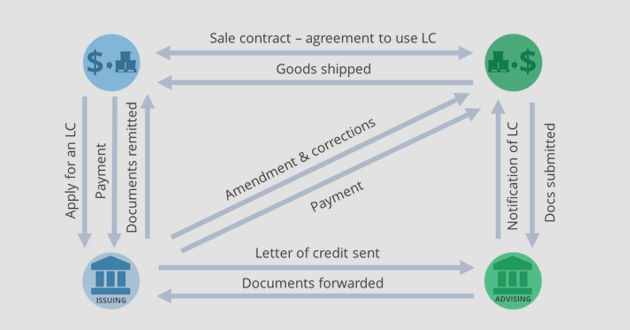
This Introduction to Letters of Credit eLearning module provides an introductory overview of Letters of Credit (LCs). It offers general awareness and information related to LCs, covering key concepts, explaining LC types, identifying the parties involved and their roles, and detailing LC conditions and logistics considerations. Total run time: approximately 45 minutes.
Following this Introduction to Letters of Credit training, students will:
- Establish a solid understanding of Letters of Credit, how they work, and their significance in global trade.
- Familiarize themselves with the main types of LCs, their common conditions, and what to look out for.
- Understand the importance of LCs in relation to logistics and their impact on shipment organization.

In this e-Learning module, we will look in detail at documents used notably in international transactions and related to the transportation of goods. We categorized them into several categories such as Trade (Invoice, …), Customs (Export declaration, Certificate of origin, …) and Nature of goods related (Hazmat, …) as well as into Standard and Special ones.
We will also introduce basics of Customs transactions and present a few Import and Export EU and USA specifics.
Total run time approx. 110 min and is split into two parts followed by a final exam.
Following this course, the student should:
- be familiar with some existing and possibly needed documents while trading internationally,
- be aware of the information these documents should or may contain,
- be able to verify some of the basic information they contain and understand it,
- understand basic customs transactions and related documents,
- be familiar with some countries specifics while exporting from or importing to them,
- be aware about some good’s nature related documents,
- be able to exchange in a credible manner with customers, service providers, and others when talking about documentation related to the international trade and transport of goods.
If you are not familiar with transport related documents, their content or different parties involved in the transport of goods, we would recommend to first view and complete the Introduction to transport documents and Transport documents course.

This course follows Introduction to customs classification (Intro – classification) and we strongly recommend viewing this introduction course prior to this one.
In this course, we will carry on with our explanation of the customs classification process we introduced in our first eLearning module Introduction to customs classification, and will talk about the official and internationally used classification rules and guidelines of the Harmonized system.
The second part of this course provides some details and an overview of the official explanations related to the Harmonized Tariff Schedule.
Total run time, approx. 55 min.
Following this course, the student should:
- understand what the General Rules of Interpretation and the Additional U.S. Rules are and how to use them,
- understand the importance of Section and Chapter notes,
- be aware about the General notes of the HTS US as well as the General statistical notes,
- be able to follow the recommended process of classification of goods for the imports to the US.

In this course, we will introduce, present and review the all important information part of the supply chain by looking at what information flows are, before reviewing some essential ones, and presenting some information systems commonly used to facilitate these flows and support the supply chain.
Total run time, approx. 30 min.
Following this course, the student should:
- understand what supply chain logistics information flows are,
- be able to recognize the most common types of information flows,
- be familiar with some of the most common kind of systems which support supply chain flows.

In this course, we will introduce, present and review a certain number of terms used to describe supply chain and logistics material flows such as outbound, inbound or milk run.
Total run time, approx. 25 min.
Following this course, the student should:
- understand what supply chain logistics flows are,
- be able to recognize the most common types of logistics material flows,
- be familiar with some of common logistics operational terms.

A training, in which, we will look at KPIs, their role in a company’s strategy, what they are and how they work, before looking at a few KPIs commonly used in the field of logistics.
Total seat time, approx. 60 min.
Following this course, the student should:
- understand the role of KPIs and PIs in a company strategy,
- understand the main characteristics of a KPI or PI and how they work,
- be familiar with some important PIs used commonly in the field of transport logistics,
- be familiar with a few other logistics and specific PIs.

In this module, we will introduce the classification of goods as per the internationally used customs Harmonized System and look at the Harmonized Tariff Schedule used for US imports.
Total run time, approx. 20 min.
Following this course, the student should:
- understand what customs classification is.
- know what HS and HTS are and what they are used for.
- be able to read, look up online, and interpret a HS or HTS customs code and find the possible applicable duty rates.
- be in position to pursue further advanced training related to the actual customs classification of goods.

In this eLearning we will talk about Incoterms®, what they are, what they are used for and how to use them before reviewing the 11 Incoterms® of the 2020 edition.
Incoterms® or International Commercial Terms are a series of pre-defined commercial terms used commonly when trading. They notably help define the rights and obligations of buyers and sellers in terms of transport organization, customs responsibilities and risk coverage.
Total run time, approx. 80 min.
Following this Incoterms training, the student should be:
- confident when working with or using Incoterms.
- able to exchange in a credible manner with customers, service providers, and other parties when using Incoterms.
- advise on, select, or short list appropriate Incoterms in relation to a logistics and supply chain situation.

A brief training presenting the changes and updates which took place between the 2010 and 2020 editions of the Incoterm® rules.
It is considered that you have completed the 2010 or 2020 training or are familiar with them prior to participating in this eLearning.
Total run time, approx. 10 min.








